Mining
![]()
This article is about mining in general; for other meanings, see Mining (disambiguation).
Mining is part of the coal and steel industry (Latin mons 'mountain'). It refers to the search for and development (exploration), extraction and processing of mineral resources from the upper earth's crust using technical equipment and resources.
According to the modern comprehensive definition, mining includes the necessary surveying (mine surveying), mine management tasks (ventilation and dewatering), social security systems (miners' funds), special training institutions (e.g. mining academies) and mining supervisory authorities. The term "montanistic" is used to describe all aspects of mining. In German-speaking countries, the terms mining, extraction of raw materials of mineral and fossil origin, and mining and metallurgy were and are also commonly used. The extraction of geothermal energy also belongs to the mining sector.
Depending on whether the deposits of mineral resources can be reached in mines ("underground"; → miner's jargon) or by opencast mining, there are different mining methods.
Mining activities are regulated worldwide by the respective mining law within the national legislation.
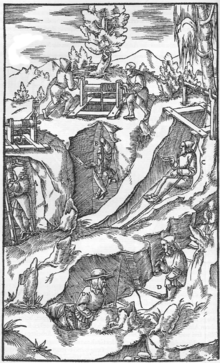
Representation of Georgius Agricola from the year 1556

Symbol of mining: hammer and iron
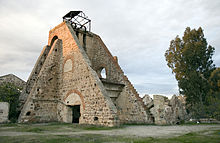
Remains of the scaffolding above the winding shaft "San Vicente" in Linares, Spain
General
Today, the extent and location of deposits are mostly investigated by geophysical exploration. This preparatory activity is often carried out outside the mining sector, by scientific institutions and government agencies. From prehistory to modern times, many deposits - for example ore veins - have been discovered through their visibility on the earth's surface (outcrops). In the future, the mining of deposits in the deep sea will become increasingly important.
In Germany, mining is basically regulated by the Federal Mining Act, in other countries by comparable legal provisions. The public body to which legal control is assigned is called the Bergamt, in Austria the Montanbehörde. In Switzerland, responsibility for mining law lies with the cantons.
History
Pre- and protohistoric mining
The oldest form of raw material extraction, known as mining, dates back to the occasional use of flint deposits in the Stone Age. Small work parties went to flint mines for a few days to obtain raw material for the manufacture of tools. In Stone Age cultures (North America, New Guinea), this method of working has persisted to some extent up to the present day. The exploitation of Mediterranean obsidian deposits is also considered to be the work of casual miners.
A permanent or seasonal mining operation presupposes agriculture with surpluses and trade, since the miners have to be fed without being able to produce food themselves and produce more products themselves than the community can utilize. The conditions for this were generally not in place until the Copper Age (Naqada culture/ copper mines of Timna in Egypt). Iran's copper mines are already Stone Age and over 6500 years old. The heyday of the Cypriot mines began 4000 years ago.
There were probably already ore mines in India and China around 3000 BC. A gold mine dated to 3000 BC is documented in Georgia. Copper mining began in central Germany around 2500 BC. Iron ore was mined in the Alps from about 800 BC. In central Germany, a furnace from the La Tène period in Wilnsdorf bears witness to mining around 500 BC. The mining of hard coal has been known in England since the 9th century.
Flint Mines
→ Main article: Flint mine
In parts of Europe, archaeologists discovered flint mines in the soft chalk bedrock:
- in Britain (Grimes Graves 2300-1700 BC),
- in France, Belgium and Holland (Rijckholt, ca. 4500-2500 BC),
- in Germany, Jutland and Poland.
The prehistoric miners dug shafts up to 15 m deep into flint-bearing strata and laid roadways. Tools used were hoes made of deer antlers and stone. A prehistoric miner and his equipment were found near Obourg in Belgium.
Ore mines
The great need of the advanced civilizations of the Near East for metals was also met early on from European mines, which were presumably developed by prospectors. Copper mines in Bulgaria and Yugoslavia have been dated by pottery finds to the 4th millennium BC. In Rudna Glava (Serbia) vertical shafts penetrate 25 m deep into the mountain. In Kőszeg, Hungary, archaeologists found a forge with metal ingots, bronze remains and clay nozzles from bellows, clay inserts for moulds, a clay crucible and over 50 stone casting moulds, in addition to an ancient copper mine. Stone moulds and equipment indicating such workshops are also known from Špania Dolina (Slovakia), from Great Britain (Alderley Edge, Cheshire) and Ireland (Mount Gabriel).
The best researched copper mining area in Europe is that of Mitterberg in the Salzburger Land. There were 32 ore mines there in the late 2nd millennium BC. Calculations have shown that 200 miners, smelters and assistants must have been working here at the same time. The ore was extracted from the pit wall by heating the rock and quenching it with water. The Bronze Age shafts were up to 100 m long. The chalcopyrite ore was carried out of the mine in panniers. Air circulation was ensured by shafts that connected the galleries lying one above the other. Ladders made of tree trunks with notches enabled the miners to access the galleries.
The copper mines of the Iberian Peninsula were developed as early as 2500 BC by a Copper Age culture (Los Millares). From here, the Bell Beaker people spread metallurgical knowledge in Europe. In ancient times the silver mines of Laurion were famous. Slaves worked there for Athenian citizens. The Romans continued to exploit the old mines in Tartessos, in Britain and Dacia (Romania) and opened up new ones in other provinces. They introduced new techniques, such as scoop wheels to drain the mines and ore washing plants.
Mining in the Middle Ages
The heyday of medieval mining in Central Europe was the 13th century. It declined in the 14th century, mainly because no new deposits were discovered. From the middle of the 15th century a new upswing set in.
In the European Middle Ages, mainly silver, copper, iron, lead and tin ores were mined. Salt mining was also important. The monasteries also played quite an important role as mining lords. In many cases, German miners passed on their expertise to more distant regions, such as France (e.g. Alsace, Vosges), Hungary, Italy (e.g. copper ore in Tuscany) and Sweden. The process also partly took place within the framework of eastern colonisation. German mining entrepreneurs were involved in Swedish mines.
Important mining areas in the Habsburg Monarchy were in Carinthia, Styria, the Salzkammergut and in Tyrol as far as Trento. The Schwaz silver treasure became a decisive factor in the financing of the Habsburg plans for world empire.
The first mining regulations were issued by Bishop Albrecht of Trento in 1185. At that time, the mining regal was with the king; in the late Middle Ages, it changed to the sovereigns. The Golden Bull also contained a mining law framework.
In the late Middle Ages, the horse-drawn ladle became an important facilitator in conveying technology. The "frog lamp" made of sheet iron began to prevail over the fragile clay and expensive cast bronze lamps; fuels here were animal fat and vegetable oil. Of course, mining was still done with hand tools.
See also: Mining in Germany
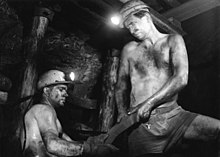
Miners in the tunnel 1961
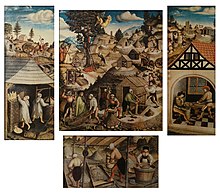
Representation of historical mining on the Annaberg mountain altar from 1522 (St. Annenkirche in Annaberg)
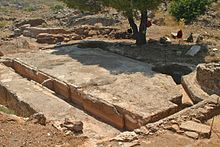
Washing plant in the silver mines of Laurion (Argileza)
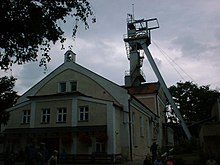
Winding tower of the Wieliczka salt mine near Krakow (Poland)
Search within the encyclopedia